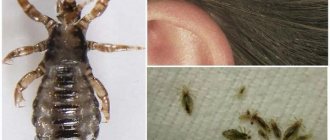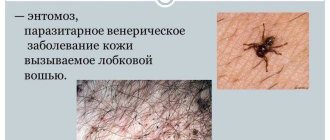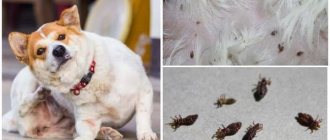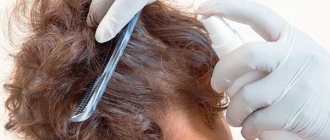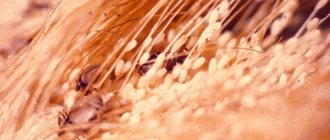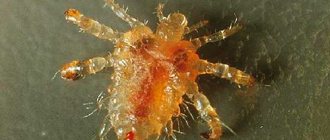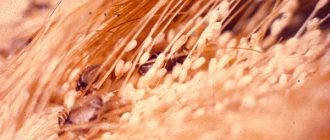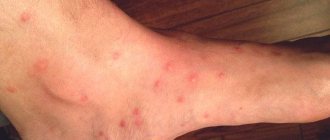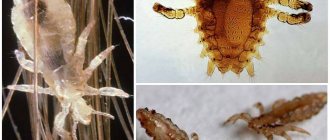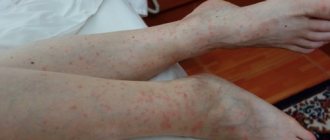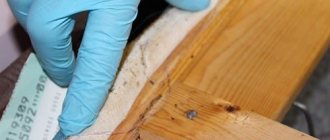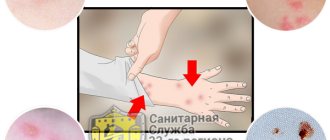Signs of pubic lice
The main symptom of phthiriasis (pubic lice infestation) is itching. It may get worse at night. Because of it, scratches and ulcers form on the skin. It is not always possible to see the insects themselves - they are small in size (no more than 2 mm, and usually much smaller). Lice attach to the hair and appear as dark specks at the base of the hair. When infected with lice pubis, black dots and grains may appear on the underwear. Parasites can live not only in the genital area, but also on the skin in the armpits and other areas of the skin covered with coarse hair (including eyelashes and eyebrows). Pubic lice never live on the scalp, since their limbs are adapted to hold only a triangular cross-section on the hair, while the hair on the head has a round cross-section.
Photo: phanuwatnandee / freepik.com
What must be done when treating phthiriasis
Pubic lice can hide not only on a person’s body, but also in his personal belongings. Therefore, during treatment, it is important to treat underwear, clothing, bedding, and towels. It is better to soak all items that can be washed in a pediculicide solution and wash at high temperature, and after drying, carefully iron or treat with a steam generator. Closets where clothes and linen are stored should be washed with a pediculicide solution. It is advisable to treat mattresses and upholstered furniture with a steam cleaner. Since lice can wait out unfavorable times in a state of suspended animation, it is necessary to do a general cleaning and wash all surfaces with an insecticide solution. This will remove insects from the home that could survive the treatment and then return to the human body.
How do you get pubic lice?
Infection can occur in several ways:
- during sex and during close bodily contact with a person already suffering from lice pubis;
- less often, infection through household means through shared bedding, linen or towels is possible;
- There is a minimal risk of infection when visiting public baths, saunas, and swimming pools.
People who frequently change sexual partners are at risk. The likelihood of infection is the same for men and women. Children can also become infected through tactile contact, close hugs, sharing towels or bed with a carrier of pubic lice.
Important! The causes and risks of infection are not related to personal hygiene: cleanliness does not affect the risk of getting lice pubis. Condoms and other barrier contraceptives do not protect against these parasites.
Pubic lice cannot jump or fly, so infection requires close and long enough contact - long enough for the insect to crawl from one person to another.
Video 1. Briefly about pubic lice. Source: blausen.com
Preventing the occurrence of mandavos
The leading method of prevention for pediculosis pubis should be considered the earliest possible diagnosis of the pathological condition, as well as therapy for patients and their sexual partners. It is strongly recommended to pay attention to the following:
- This is what will prevent the further spread of lice.
- In order not to encounter frontal lice in the future, experts strongly recommend being more selective in your sexual life and when choosing sexual partners.
- Of course, the presented recommendation applies to all diseases that can be sexually transmitted, namely STDs.
In addition, it will be very important to observe truly basic standards of personal hygiene. For example, both bedding and underwear should be clean. If you are forced to spend the night in a hotel (if its cleanliness is in doubt), it would be best to use your own bed linen. In addition, it is strongly recommended to shower immediately after sexual intercourse. As general recommendations, I would like to mention the importance of maintaining a healthy lifestyle, as well as strengthening the body by hardening and using vitamin and mineral components.
What do pubic lice look like?
Pubic lice are dark red or yellow-gray insects. They have six legs, of which the front pair are of increased size. The parasite uses them to cling to hair. The length of the insect usually does not exceed 2 mm. It looks like a dark speck at the very base of the hair. Pubic lice differ from head lice in body structure (it is round, not oblong), and size (it is smaller).
Figure 1. Differences between pubic louse and head louse and body louse. Source: rospotrebnadzor.ru
Lice reproduce by laying pale brown nits (eggs). They may look like thickening of the hair at its very base.
Figure 2. Pubic lice on the skin. Source: Springer Science+Business Media
Reproduction
Female individuals lay eggs 3 to 6 times a day. On average, an adult lives about 46 days. During this period of time, the female lays about 140 eggs. A cocoon is formed around the egg, which, thanks to the sticky secretion secreted by the lice, attaches and remains on the hair for a long time. The egg and cocoon are called nits. The length of nits is about 1 mm.
After 5 - 8 days, a larva (nymph) emerges from the nit. She looks like an adult parasite. The larva grows and develops in 14–16 days. During this time she sheds 3 times. After the third molt, the nymph turns into an adult. Nymphs of the first period develop 5 days, the second - 8 days,
The cycle from egg laying to the next generation's first egg laying is 18 to 22 days. A temperature of 32-33°C is ideal for reproduction. Under unfavorable environmental conditions, the reproduction of parasites slows down.
Rice. 15. The photo shows the reproduction cycle of lice from egg to egg, which lasts from 18 to 22 days.
Rice. 16. The photo shows the transformation of a nymph into an adult.
Symptoms
With phthiriasis, parasites live on hair in the pubic area, perineum, anus, and armpits. Less commonly affected are eyebrows, eyelashes, beard and mustache, and hair-covered skin of the back, chest, and abdomen in men.
When infected, the following symptoms appear:
- frequent itching of the affected areas, which may worsen at night;
- the appearance of ulcers, small blue or bluish spots in the affected area;
- inflammation, skin irritation.
The main symptom is itching, but up to several weeks can pass between infection and its appearance, during which the person will be a carrier of parasites. Ulcers and spots appear on the skin later as a reaction to insect bites or scratching itchy skin. If you suspect pubic pediculosis, you should contact a dermatovenerologist.
Diagnosis of the disease
For diagnosis, examination of the affected area is sufficient. There is no need to take tests or conduct special studies. The examination may be performed using a magnifying glass or examining the hair under a microscope (rarely required). The doctor will examine the areas where itching occurs most often, as well as other areas of the skin that are covered with coarse hair. All patients are examined in the areas of the genitals, anus, armpits, eyebrows, eyelashes. In men, the beard and other areas covered with hair are additionally examined - chest, back, abdomen, legs, arms.
Pubic lice in the armpit area. Photo: Chinese medical journal / Open-i (CC BY-NC-SA 3.0)
A medical examination is necessary to rule out other skin diseases and allergies and prescribe the correct treatment.
The doctor may additionally refer the patient for examination to exclude sexually transmitted diseases. Pubic lice do not carry such diseases, but infestation with phthiriasis may indicate an increased risk of other sexually transmitted infections.
How to remove parasites: effective means
To treat phthiriasis, external, local drugs are used - they are prescribed by a doctor. There are several effective remedies.
Dimethicone
May be part of a complex of mineral oils, does not contain insecticides. Available as shampoo, spray or lotion. Can be used for children aged three years and older.
Permethrin
An external cream based on this substance is used to treat or prevent head lice. Also comes in shampoo form. The preventive effect can last for a period of two to six weeks.
Boric acid
Medicinal ointments have been developed based on this active ingredient. According to the instructions, the ointment is applied to the scalp and then washed off. The hair is combed out with a comb. The treatment can be repeated daily. Additionally, boric ointment has an antiseptic effect.
In any case, you should consult your doctor before using any drug. It is also important to study the instructions so as not to cause harm by self-medication.
Almost all medications for lice pubis contain permethrin, an insecticidal substance. It destroys pubic lice and nits, paralyzing them and stopping their breathing. Permethrin has a characteristic orange-brown color and a specific odor. Preparations containing this insecticide should be used strictly as prescribed by a doctor and with caution:
- the substance may cause allergies, redness of the skin, increased itching, burning, tingling or tingling;
- when treating phthiriasis and applying products containing permethrin to the skin in the genital area, it is necessary to avoid its contact with the mucous membranes;
- insecticides are not used to kill pubic lice on eyebrows and eyelashes;
- when using insecticidal creams, ointments, shampoos, it is advisable to protect the skin of your hands with disposable gloves or wash your hands thoroughly with soap immediately after using the drug;
- External products based on permethrin are not used to treat head lice in children.
Age restrictions are indicated in the instructions for a specific drug. If a child is infected with phthiriasis, any insecticidal preparations can be used only as prescribed by a doctor.
To reduce the risk of a local reaction, before using a cream, lotion, shampoo or other product containing permethrin, you can apply a small amount to the skin to see if it causes allergies, itching, burning or other unpleasant symptoms.
Folk remedies
Traditional medicine involves the use of a mixture of vegetable oil with kerosene, essential oils, petroleum jelly, and other products that need to be applied to the affected area. This treatment is ineffective: if it leaves at least a few live insects or eggs, pubic lice will continue to multiply. The use of kerosene and other aggressive agents is dangerous: there is a risk of injuring the skin and causing allergies. It is better to use medications prescribed by your doctor. A single use of insecticides is enough to get rid of phthiriasis.
Important! If you are infected with lice pubis, you should not try to treat the disease yourself: some remedies can stimulate the proliferation of pubic lice. Therefore, for diagnosis and treatment you need to contact a dermatovenerologist.
After treating the skin with insecticidal agents, it is necessary to wash clothes, bedding and any other things that may have pubic lice on them. Washing is carried out at a temperature not lower than +50°C.
Summing up
The appearance of flat spots causes not only physical discomfort in a person. For most, the disease is shameful, so many are simply embarrassed to turn to specialists for help. Instead, the patient tries to get rid of the parasites on his own, often choosing not the most effective treatment methods.
By consulting a doctor, you can be sure that you will be prescribed a proven drug that will be effective and will allow you to get rid of insects in a short time. Self-medication can only worsen the situation. You know what pubic lice are and why they are dangerous. All that remains is to take care of protecting yourself from bloodsuckers. If this was not possible, you should definitely not be embarrassed to visit a specialist who will provide qualified assistance.
Consequences and complications
If lice pubis is not treated, the parasites will continue to multiply. A sick person will infect people in close contact with him. The risks to his health are mainly associated with inflammation, the appearance of ulcers on the skin, and the addition of a secondary infection.
After treatment for several weeks, dead nits may be found on the affected area. This does not require re-treating the skin or hair with the insecticide.
If a pregnant woman becomes infected with phthiriasis, drugs with a minimum concentration of the toxic active substance are chosen during treatment. Pediculosis pubis is not dangerous for newborns; they cannot catch it from their mother. The risks of phthiriasis during pregnancy are associated mainly with the addition of a secondary infection if the disease is accompanied by severe itching and the appearance of ulcers, scratching, and inflammation on the skin.
Preventive measures
You can reduce the risk of contracting lice pubis by avoiding casual sex. Condoms and other methods of barrier contraception do not protect against phthiriasis. For prevention, it is important to use personal towels, underwear and bed linen, and change them regularly. A good preventative measure is epilation or depilation - hair removal in the bikini area, armpits, and other areas. It improves the quality of personal hygiene, reduces the risk of pubic lice infection, and can be performed for both women and men.
Image/Depositphotos
